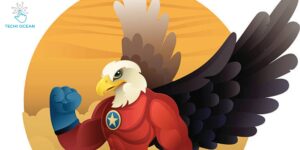Muppet Characters with Long Beaks in Henson’s World
The idea of a “Muppet with a Long Hooked Beak” points towards a unique and distinctive character design often associated with the creative universe of The Muppets, known for its quirky, colorful, and imaginative cast. However, there isn’t a specific Muppet by that description across The Muppets series that fits the exact label. But if we explore creatures or characters within the broader Jim Henson universe (including Muppets, Sesame Street, and other projects), we do find some bird-like or avian characters with distinctive features that might resemble the description of having a “long hooked beak.”
1. Sam the Eagle
Sam the Eagle is one of the prominent Muppet characters and, while his beak is not particularly long or hooked, he represents the “eagle” motif with his stern, bureaucratic personality. Sam is often portrayed as overly serious, rigid, and proud, contrasting with the usual zaniness of other Muppets. His beak, while not elongated, is still a prominent feature of his character design, giving him a bird-like presence.
2. Beauregard the Stagehand
While Beauregard, a lesser-known Muppet character, isn’t necessarily bird-like, his prominent nose could, in some interpretations, be seen as a beak-like feature. His appearance is more unconventional, with large facial features that make him look both amusing and clumsy. Some fans may loosely associate his long, hooked nose with the idea of a bird beak, though it’s a stretch in terms of description.
3. Big Bird (Sesame Street)
A character with a more explicitly long beak is Big Bird from Sesame Street. Big Bird’s design fits the bill (pun intended) more closely with his large, yellow feathers and long, slender beak. Although not exactly “hooked,” his beak is certainly one of his defining features. As one of the most iconic creations by Jim Henson, Big Bird’s beak is more elegant and child-friendly rather than imposing or sharp.
4. The Skeksis from The Dark Crystal
If we broaden our scope to Jim Henson’s darker fantasy work, specifically The Dark Crystal, we find the Skeksis, a race of vulture-like creatures. These characters have long, hooked, beak-like noses, which are integral to their design. The Skeksis are menacing, ancient beings who symbolize greed and decay. Their vulture-inspired features, including long hooked beaks, could match the description you’re referring to. These characters have a much more ominous and sinister look compared to the more whimsical Muppets, making them a standout design in Henson’s creature catalog.
Why the Beak is Important in Design
The use of a long, hooked beak, particularly in creature design, can symbolize several traits depending on how it’s implemented. In the case of Muppets or Henson’s creations:
- Wisdom and Authority: Beak-like noses or features often give characters a sense of gravitas, especially if paired with eagle or vulture imagery (e.g., Sam the Eagle or the Skeksis).
- Humor and Exaggeration: The Muppet aesthetic thrives on exaggeration, and beak-like features help push characters into the realm of absurdity and fun.
- Animalistic Features: Avian traits, such as a hooked beak, invoke a natural connection to birds of prey or scavengers, creating either a sense of elegance or menace, depending on the character’s role.
The Art of Puppetry and Character Design
An important part of the appeal of the Muppets and other Jim Henson creations is the attention to detail in character design. The beak, nose, and other exaggerated features serve as focal points for conveying emotion, personality, and even comedic timing. For example, the hooked beaks of characters like Sam the Eagle and the Skeksis from The Dark Crystal are not just visual quirks but serve as extensions of their personalities—rigid, controlling, or predatory. You could discuss how Jim Henson’s team used these features to add layers of meaning to each character, shaping the viewer’s perception from the moment the puppet appears on screen.
Adding more background on how puppetry and physical features play a role in creating iconic characters can expand the scope of the article. Consider addressing the following:
- Character Construction: How physical elements like a beak, elongated nose, or large eyes are designed to be expressive even with limited movement.
- Material Choices: The importance of using soft materials for children’s characters (like Big Bird) and more rigid materials for ominous figures like the Skeksis.
Muppets in Popular Culture
Discussing the cultural impact of the Muppets and how characters with distinctive features like long beaks have become symbols of broader ideas or movements in entertainment can be another layer of depth. For example, Sam the Eagle represents patriotism, authority, and sometimes satire of government bureaucracy, making him a reflection of societal views.
You could expand on how:
- Sam the Eagle has become a satire of American patriotism and seriousness, often used in contexts where the Muppets mock overly serious attitudes. His beak enhances his stern appearance, adding to the comedic contrast when paired with his conservative personality.
- The Skeksis from The Dark Crystal have become symbols of power and corruption, with their vulture-like, hooked beaks symbolizing greed and decay. Their design was inspired by scavenger birds, which have strong cultural associations with death and predation.
Bird Symbolism in Muppet and Henson Creations
Bird symbolism plays a significant role in Jim Henson’s creations, extending beyond physical appearance to how these characters interact with their world. Birds are often seen as symbols of freedom, wisdom, or even trickery in various cultures. These themes come to life in Muppets like Sam the Eagle or characters in The Dark Crystal.
You could explore how:
- Birds of Prey (eagles, vultures) are often chosen to represent authority, surveillance, or impending doom. The use of such motifs in Muppet characters brings a layered depth to children’s and adult programming alike.
- Bird Symbolism contrasts in different contexts, such as the difference between Big Bird’s childlike innocence and the menacing, predatory nature of the Skeksis.
Behind the Scenes: Creation and Operation of Beaked Muppets
Going behind the scenes to understand how these Muppets are operated, designed, and brought to life can add a fascinating technical layer to the article. The intricate work of puppeteers in synchronizing beak movements with voice acting or expressive motions makes the characters feel alive.
Some additional behind-the-scenes details could include:
- Puppetry Mechanics: How beak movements are controlled, especially for characters like Sam the Eagle, whose stern look requires precise control for subtle expressions.
- Voice and Design Synergy: The pairing of a character’s physical design (such as a long beak) with the right voice actor to bring out the desired personality traits.
Notable Appearances and Legacy
Sam the Eagle, for example, has made appearances in The Muppet Show, Muppet Treasure Island, and The Muppets (2011), where his rigid attitude contrasts with the chaos around him.
Similarly, the Skeksis in The Dark Crystal have gained renewed attention due to the release of The Dark Crystal: Age of Resistance on Netflix, bringing back their iconic designs to new audiences.
Comparison with Other Bird-Like Characters in Pop Culture
Another expansion could include a comparison between the beaked characters in the Muppet universe and bird-like characters in other media, such as animated films or comic books. How do these characters compare in terms of personality, design, and cultural significance? For example:
- Zazu from The Lion King: A serious, rule-following hornbill that, like Sam the Eagle, often provides a voice of reason but also becomes the butt of jokes.
- Beaky Buzzard from Looney Tunes: A somewhat goofy vulture who contrasts the more serious nature of the Skeksis in The Dark Crystal.
The Role of Exaggerated Features in Comedy
Exaggerated physical features, including long hooked beaks, play a big role in Muppet-style humor. You can expand on how these features add to slapstick comedy, subtle satire, or visual gags. For instance, Sam the Eagle’s serious demeanor is often at odds with his ridiculous surroundings, making his beak an essential comedic element in creating that contrast.
Conclusion
While there is no single Muppet universally recognized as the “Muppet with a long hooked beak,” the description can apply to several characters within the Muppet or broader Jim Henson world, particularly when considering figures like Sam the Eagle or the Skeksis from The Dark Crystal. The use of avian-like features in character design enhances the storytelling, giving depth, humor, or intimidation to the puppets and creatures that define Jim Henson’s legacy. Whether through the whimsical, childlike charm of Big Bird or the eerie menace of the Skeksis, the “beak” plays a vital role in shaping the personality and appeal of these beloved characters.









